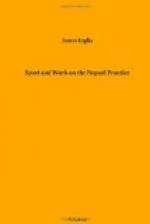On many of the banks bordering the roads, thatching grass, or rather strong upright waving grass, with a beautiful feathery plume, is planted. This is used to make the walls of the houses, and these are then plastered outside and in with clay and cowdung. The tall hedge of dense grass keeps what little breeze there may be away from the traveller. The road is something like an Irish ‘Boreen,’ wanting only its beauty and freshness. On a hot day the atmosphere in one of these village roads is stifling and loaded with dust.
These houses with their grass walls and thatched roof are called kutcha, as opposed to more pretentious structures of burnt brick, with maybe a tiled sloping or flat plastered roof, which are called pucca. Pucca literally means ‘ripe,’ as opposed to cutcha, ‘unripe’; but the rich Oriental tongue has adapted it to almost every kind of secondary meaning. Thus a man who is true, upright, respected, a man to be depended on, is called a pucca man. It is a word in constant use among Anglo-Indians. A pucca road is one which is bridged and metalled. If you make an engagement with a friend, and he wants to impress you with its importance, he will ask you, Now is that pucca?’ and so on.
Other houses in the village are composed of unburnt bricks cemented with mud, or maybe composed of mud walls and thatched roof; these, being a compound sort of erection, are called cutcha pucca. In the cutcha houses live the poorer castes, the Chumars or workers in leathers, the Moosahms, Doosadhs, or Gwallahs.
The Dornes, or scavengers, feeders on offal, have to live apart in a tolah, which might be called a small suburb, by themselves. The Dornes drag from the village any animal that happens to die. They generally pursue the handicraft of basket making, or mat making, and the Dorne tolah can always be known by the pigs and fowls prowling about in search of food, and the Dorne and his family splitting up bamboo, and weaving mats and baskets at the doors of their miserable habitation. To the higher castes both pigs arid fowls are unclean and an abomination. Moosahms, Doosadhs, and other poor castes, such as Dangurs, keep however an army of gaunt, lean, hungry-looking pigs. These may be seen rooting and wallowing in the marshes when the rice has been cut, or foraging among the mango groves, to pick up any stray unripe fruit that may have escaped the keen eyes of the hungry and swarming children.




